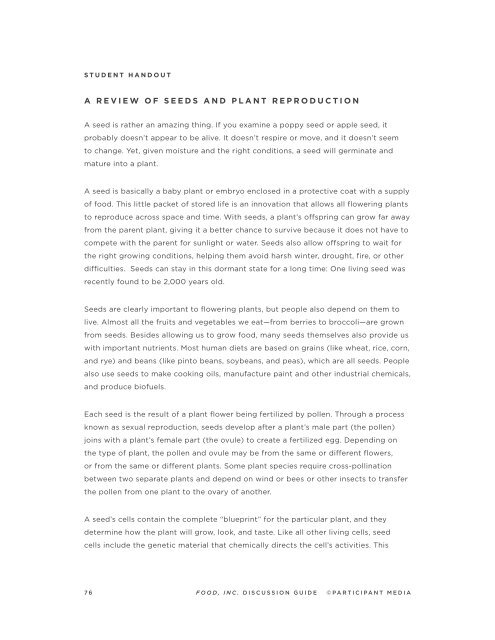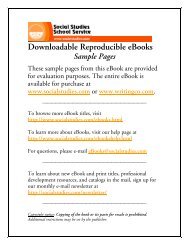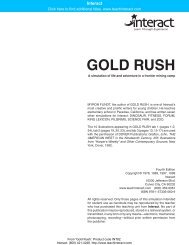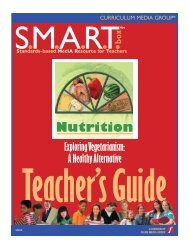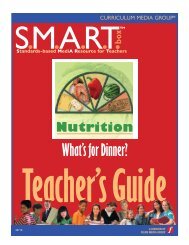S t u d e n t H a n d o u tA R e v i e w o f S e e d s a n d P l a n t R e p r o d u c t i o nA seed is rather an amazing thing. If you examine a poppy seed or apple seed, itprobably doesn’t appear to be alive. It doesn’t respire or move, and it doesn’t seemto change. Yet, given moisture and the right conditions, a seed will germinate andmature into a plant.A seed is basically a baby plant or embryo enclosed in a protective coat with a supplyof food. This little packet of stored life is an innovation that allows all flowering plantsto reproduce across space and time. With seeds, a plant’s offspring can grow far awayfrom the parent plant, giving it a better chance to survive because it does not have tocompete with the parent for sunlight or water. Seeds also allow offspring to wait forthe right growing conditions, helping them avoid harsh winter, drought, fire, or otherdifficulties. Seeds can stay in this dormant state for a long time: One living seed wasrecently found to be 2,000 years old.Seeds are clearly important to flowering plants, but people also depend on them tolive. Almost all the fruits and vegetables we eat—from berries to broccoli—are grownfrom seeds. Besides allowing us to grow food, many seeds themselves also provide uswith important nutrients. Most human diets are based on grains (like wheat, rice, corn,and rye) and beans (like pinto beans, soybeans, and peas), which are all seeds. Peoplealso use seeds to make cooking oils, manufacture paint and other industrial chemicals,and produce biofuels.Each seed is the result of a plant flower being fertilized by pollen. Through a processknown as sexual reproduction, seeds develop after a plant’s male part (the pollen)joins with a plant’s female part (the ovule) to create a fertilized egg. Depending onthe type of plant, the pollen and ovule may be from the same or different flowers,or from the same or different plants. Some plant species require cross-pollinationbetween two separate plants and depend on wind or bees or other insects to transferthe pollen from one plant to the ovary of another.A seed’s cells contain the complete “blueprint” for the particular plant, and theydetermine how the plant will grow, look, and taste. Like all other living cells, seedcells include the genetic material that chemically directs the cell’s activities. This7 6F o o d , I n c . D I S C U S S I O N G U I D E© P a r t i c i p a n t M e d i a
genetic material—called deoxyribonucleic acid or DNA—is the same in every cell ofa particular organism. While all DNA is made from the same four chemical buildingblocks, each plant has a unique DNA sequence that determines its characteristics.The DNA in seed cells comes from the parent plants and transfers characteristics fromthe parent to the offspring. With sexual reproduction, the genetic information in seedsis a combination of both the male and female parent parts. This allows new geneticcombinations that produce slight variations in the plant’s traits.Over the 10,000 years that people have been practicing agriculture, they have beenimproving crops by selecting plants with desired traits, and saving seeds from thoseplants to sow the following year. By doing so, people have developed plants thatare more productive, tasty, frost- or drought-resistant, and easy to harvest than theoriginal wild plants. Modern-day grains, beans, and other crops were developedthrough this process.In the past few decades, people have been using a new process, called geneticmodification or bioengineering, to develop plants with specific traits. With thisprocess, scientists in a laboratory change the DNA sequence of a plant by adding,duplicating, deleting, or inserting pieces of DNA from other organisms—like bacteriaor viruses—to produce certain plant traits.Genetic modification speeds up the process of improving plants, which otherwisecan take many, many years for even small changes. It also allows people to developplants with new traits that cannot be found in nature, such as the ability to resistspecific diseases. But genetic modification also raises many concerns. For one thing,we do not know all the long-term consequences of genetic modification to humanhealth or the environment. For another, there is no way to keep genetically modifiedcrop varieties separate from conventional varieties when they are cross-pollinatedby wind and insects; in fact, people have already found genetically modified DNAin conventional corn, soybeans, and canola seeds. 6 Other concerns are that the useof genetic modification may lead to fewer species and less genetic variety withinspecies, and that it may give bioengineering companies too much control over theworld’s food production.6 Union of Concerned Scientists. “FAQs: Seed contamination.” http://www.ucsusa.org/food_and_agriculture/science_and_impacts/impacts_genetic_engineering/faqs-seed-contamination.html.7 7F o o d , I n c . D I S C U S S I O N G U I D E© P a r t i c i p a n t M e d i a
- Page 8 and 9:
L e t t e r f r o m Z e n o b i a B
- Page 10 and 11:
U s i n g t h i s G u i d eThis gui
- Page 12 and 13:
N at i o n a l S ta n d a r d s C o
- Page 14 and 15:
g Analyze the extent to which group
- Page 16 and 17:
About SocraticDiscussionsFood, Inc.
- Page 18 and 19:
to a deeper understanding of the is
- Page 20 and 21:
A s s e s s i n g S o c r at i c D
- Page 22 and 23:
2 2F o o d , I n c . D I S C U S S
- Page 24 and 25:
In this factory farming model, a si
- Page 26 and 27: • If we are in consensus that eve
- Page 28 and 29: S t u d e n t H a n d o u tL u n c
- Page 30 and 31: 3 0F o o d , I n c . D I S C U S S
- Page 32 and 33: eakfast cereals, salad dressings, m
- Page 34: S o c r at i c D i s c u s s i o nF
- Page 37 and 38: S t u d e n t H a n d o u tC o r n
- Page 39 and 40: c h a p t e r 3Unintended Consequen
- Page 41 and 42: on contaminant tests that do not gi
- Page 43: • The mother says, “Sometimes i
- Page 46 and 47: 4 6F o o d , I n c . D I S C U S S
- Page 48 and 49: B a c k g r o u n d I n f o r m at
- Page 50 and 51: S o c r at i c D i s c u s s i o nF
- Page 52 and 53: I d e a s f o r A c t i o n• Enco
- Page 54 and 55: 5 4F o o d , I n c . D I S C U S S
- Page 56 and 57: B a c k g r o u n d I n f o r m at
- Page 58 and 59: S o c r at i c D i s c u s s i o nF
- Page 60 and 61: R e f l e c t i o nThe film describ
- Page 62 and 63: 6 2F o o d , I n c . D I S C U S S
- Page 64: On the face of it, cheap, abundant
- Page 67 and 68: easons. Do you think economics is a
- Page 69 and 70: 6 9F o o d , I n c . D I S C U S S
- Page 71 and 72: C h a p t e r 7From Seed to theSupe
- Page 73 and 74: As depicted in the film, companies
- Page 75: • Why might we care whether Monsa
- Page 79 and 80: c h a p t e r 8The VeilS y n o p s
- Page 81 and 82: One of the issues of regulation poi
- Page 83 and 84: • In the film, Barbara Kowalcyk a
- Page 85 and 86: 6 Do the Nutrition Facts affect whe
- Page 87 and 88: c h a p t e r 9Shocks to the System
- Page 89 and 90: S o c r at i c D i s c u s s i o nF
- Page 91 and 92: I d e a s f o r A c t i o n• From
- Page 93: Things You Can DoYo u c a n vot e t
- Page 96 and 97: ResourcesFor additional information
- Page 98 and 99: Center for Science in the Public In
- Page 100 and 101: p h o t o c r e d i t s©istockphot
- Page 102 and 103: A b o u t P a r t i c i p a n t M e


